This post may contain affiliate links at no additional cost to you. As an Amazon Associate I earn from qualifying purchases. Click to view our full disclosure.
What's inside
You may have heard about the 100 squats a day challenge.
It’s a challenge where participants perform 100 squats a day for 30 days. Going viral in 2018, it gained the interest of fitness enthusiasts and non-lifters alike.
Participants have to prove to themselves that they can not only do the 100 squats, but have the discipline to stick it out for 30 days.
As a personal trainer, I think squats are a fantastic lower body exercise. But are there any real benefits to performing 100 of them daily for a month?
Today, I will discuss the 100 squats a day challenge, the benefits and results, and we can figure out whether this is worth the effort or just another fad.
Let’s jump in.
What are squats good for?
Related: Do Squats Work Abs?
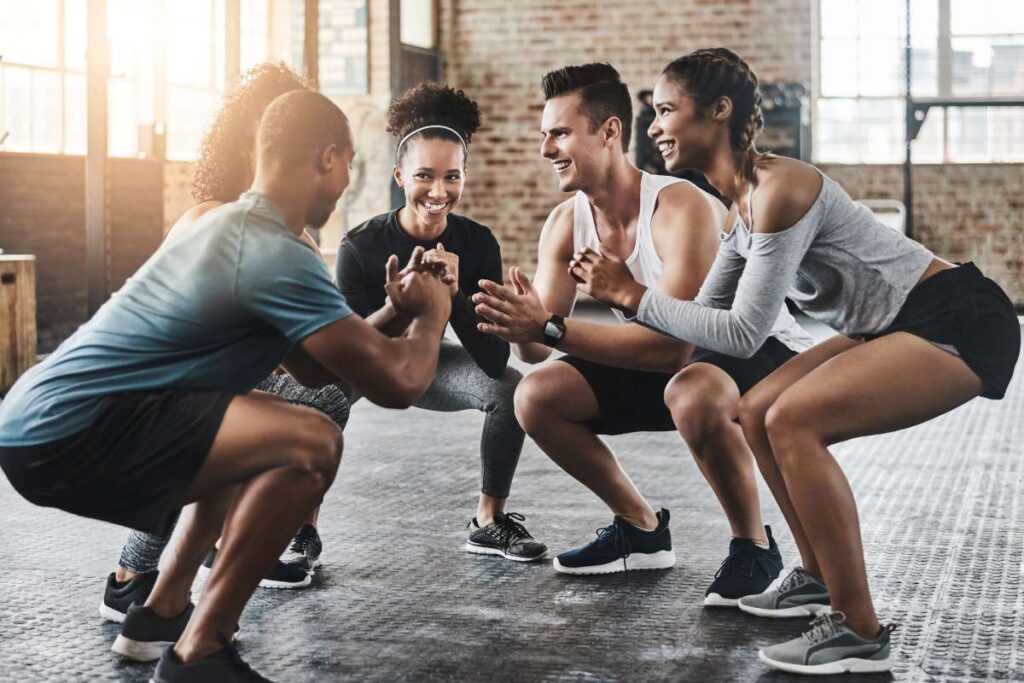
Squats are good for developing lower body strength, building muscle mass, and improving function.
The squat uses the hip hinge. This is a fundamental movement not only in the gym but in daily life. The squat teaches us how to move and lift with the largest and most powerful joint in the body, the hips.
This transfers to daily tasks such as sitting down, standing up, and lifting objects, and other lifts in the gym such as the deadlift, front squat, back squat and lunges.
Why do 100 squats a day?
Related: How Much Should I Be Able To Squat?
Doing 100 squats a day is an incredible challenge for the body and the mind.
While the physical challenge of performing 100 squats a day is tough enough, the true test will be on your mind, and whether you can reach the 30-day mark.
Over this time, you will see changes to your muscular endurance, strength, and mass. You can even lose weight if you’re also in a caloric deficit while performing the challenge.
It’s safe to say that by the end, you will have improved your physical fitness. And more importantly, you can show yourself that you can commit to your training goals.
What is the 100 squats a day for 30 days challenge?
Related: 12 Best Ab Wheel Exercises
The 100 squats a day for 30 challenge is where an individual performs 100 squats a day for 30 days straight.
It challenges your mind and body, but benefits the mind and body as well.
Muscles Used During Squats
Before we break down the benefits, here’s a list of muscles we’re working when we squat. As you can see, squats involve some of our biggest, most important muscles:
- Glutes
- Quadriceps
- Hamstrings
- Adductors
- Core
Muscle Benefits of Squats
Related: Tired Of Skinny Legs With Big Belly?
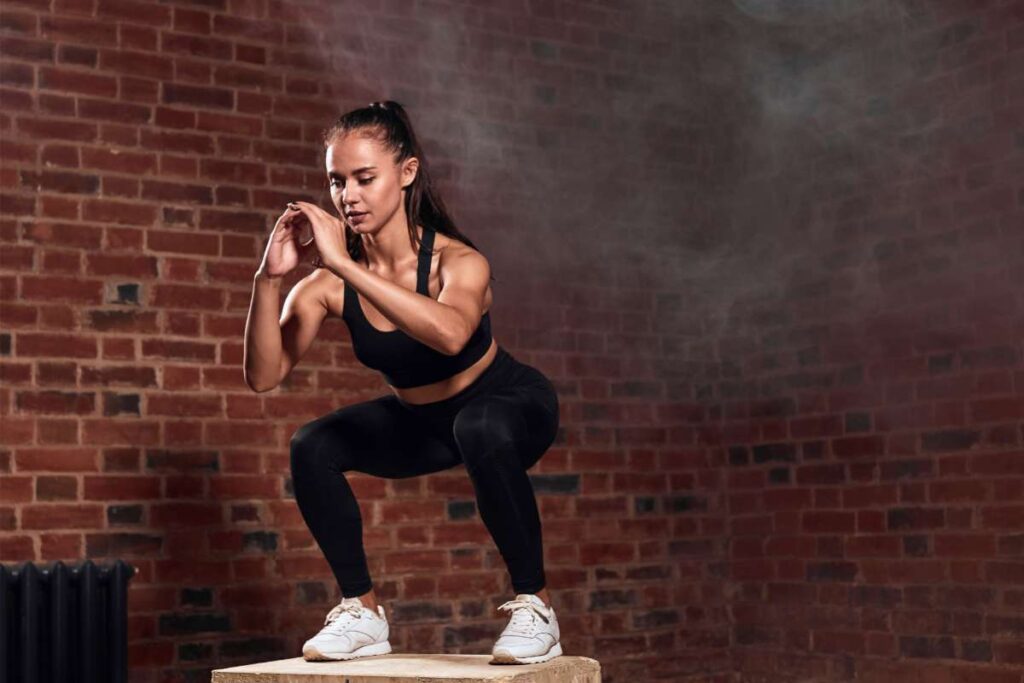
Now let’s examine exactly how muscles benefit from performing squats.
Strengthens Tendons
Squats can be used to improve tendon strength and stiffness.
Research suggests that when we perform resistance training exercises, our tendons get stiffer, which can increase the ability to generate force.
Increase Muscle Mass
Squats are considered one of the most effective ways to increase muscle mass in the lower body.
Plus, when we perform squats, we have the ability to load the movement with the barbell as a back squat or in the front squat position.
Research suggests that performing sets of eight to 12 repetitions at 70%-85% of your 1RM (one repetition maximum) is the most effective way to promote muscle hypertrophy.
Improve Strength
The squat is incredible for improving muscular strength, especially if we use the barbell to increase load.
When we do this, we can put a stimulus on our lower body that will force our muscles to adapt.
Studies suggest performing sets of one to five repetitions at 80%-100% of your 1RM to improve muscular strength.
Improves Performance
Performing squats is beneficial to athletic performance. Scientific literature describes how squatting improves an athlete’s jumps as well as knee and hip extension.
By improving activation of their hip extensor muscles, squatting encourages stronger and more powerful movements.
Health Benefits of Squats
Related: How To Lose Upper Body Fat

Here is a list of health benefits you might get from performing squats.
Improves Daily Function
Squats are an incredible exercise for improving daily function, as they strengthen the glutes and quadriceps.
Research identifies that quadricep and gluteus maximus muscles have the highest activity when knees are at 90 degrees, or parallel, in a squat.
This can bolster our function with movements such as standing up, sitting or stooping down, and lifting objects.
These fundamental movements are often lost as we get older. By strengthening ourselves through this range of motion we improve our quality of life as well as basic function.
Burns Calories
Squatting is a great exercise for burning calories since they use muscles of the lower body to perform the movement.
A study conducted in 2017 identified that half-squats performed at 80% of 1RM, with an average of 11 reps, were the most efficient movements for burning calories.
This outperforms the leg press, bench press, and leg curls with a registered 11 kcal per minute.
So, it’s a good way to burn extra calories while improving muscular strength, function, and endurance.
Weight Loss
A squats’ ability to burn calories can be beneficial for weight loss and weight management.
If you take on the 100 squats a day challenge, you will be burning extra calories. Combining this with a planned caloric deficit will help you lose weight and give you a leaner-looking physique.
Increase Bone Density
Resistance training has long been associated with better bone density.
Research suggests that performing resistance training exercises with a load exceeding what we experience in daily life will help improve bone density.
This helps to preserve bone mass as we age, decreasing the risk of bones breaking due to falls.
Improves Muscle Activation
When we perform a resistance exercise, we have the opportunity to tense and squeeze the working muscles.
When we actively contract our working muscles, we develop our mind-muscle connection.
This, done at lighter loads like that of a squat challenge, can help us improve control, which carry over into other lower body lifts in the gym.
How To Do a Squat
Related: Full Body Workout Every Other Day
The squat is a complex movement. Even with no resistance, it can be a highly effective way to improve strength and function.
Equipment Requirements
- Floor Space
How To Perform a Squat
- Stand with feet shoulder-width apart and toes angled outward 30 degrees.
- Hold hands out in front of you so that your arms are parallel with the floor.
- Begin the movement by unlocking the hips and lower yourself down toward the floor.
- Lower until your hips and knees are flexed at 90 degrees.
- Once at the bottom of the movement, pause for one second and push yourself back up to the starting position. Repeat
Benefits
- Increases muscle strength
- Improves function
Pro Tips
- When performing the squat, lead back with the hips. This helps you perform the squat using the hips, evenly distributing the load through the hips, knees, and ankles.
- If you’re struggling with balance or are afraid of falling back, consider performing squats onto a chair to begin with. This will help you build confidence in your ability to perform the movement.
Equipment You Can Use While Doing Squats
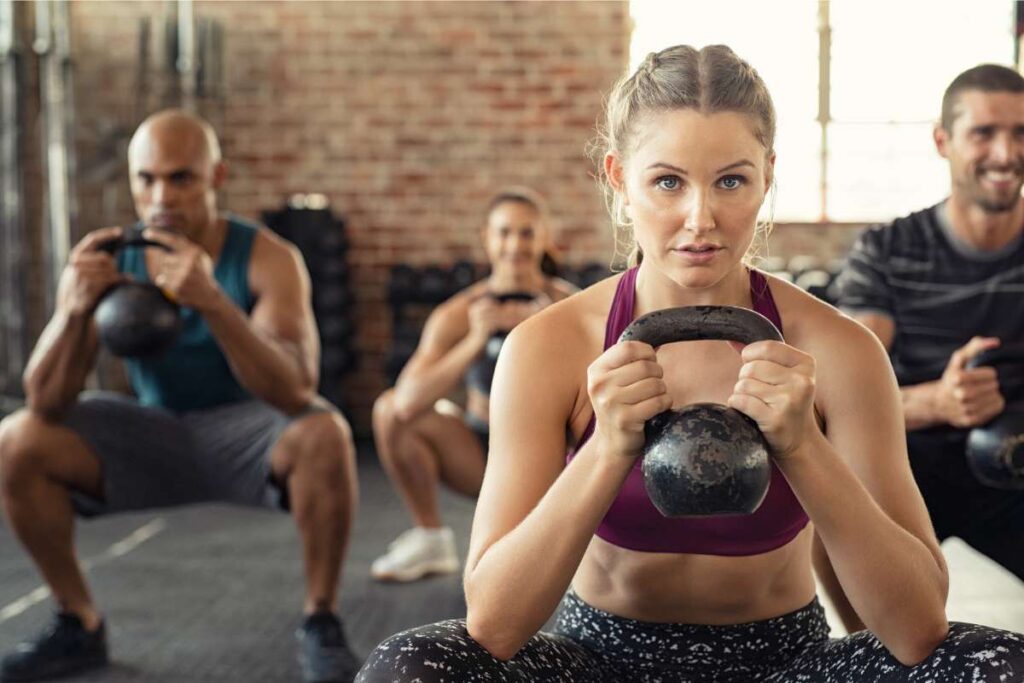
Using equipment is a great way to load the body for additional resistance. This is how we progressively overload the body to build strength and promote muscle hypertrophy.
Here’s a list of different pieces of equipment you can use to increase the resistance of your squats:
Barbell
The barbell is one of the most effective ways of increasing weight for your squats. This can be done by simply loading the barbell onto your back, or with a squat rack for greater loads.
Secure the position by loading the barbell onto the belly of your upper trap, and across the top of your scapula.
The body and spine supports your load while increasing resistance for your legs.
Dumbbell
Dumbbells are a great tool for introducing weight to your squats, as they can be comfortably held in your hand.
This is perfect for anyone who wants to load their squats, but isn’t ready to load up with a barbell.
It’s also easier to start lighter with dumbbells. Increase in small increments until you are confident enough to graduate to a barbell.
Kettlebell
Kettlebells are a versatile piece of equipment that are excellent for loading your squats.
You can hold them in the full rack position, half-rack position, or at chest height for a goblet squat.
Holding a kettlebell in these positions are great for engaging the upper body and core as you brace yourself throughout your squat.
Resistance Bands
Resistance bands are an affordable option for home gym owners. They’re also portable, making them great for when you’re away from the gym or on vacation.
Use the resistance band by anchoring one end under your feet, while holding the other end or looping it over your shoulders.
This also provides a different kind of resistance than conventional weights that use gravity.
As you reach the upright position, the band will increase in resistance, making it more difficult to hold and rest at the top of the movement.
Cables
Cables use a pulley-based system that offers continuous resistance through the entire range of motion of the squat.
One of the great things about cables is their versatility. The pulleys can be set to your height, with the added benefit of rotating pulleys, which will adjust to your position.
This, combined with a variety of different hands such as the V-grip, straight bar, belt, and handles, makes for an array of different loading options.
9 Different Squat Variations
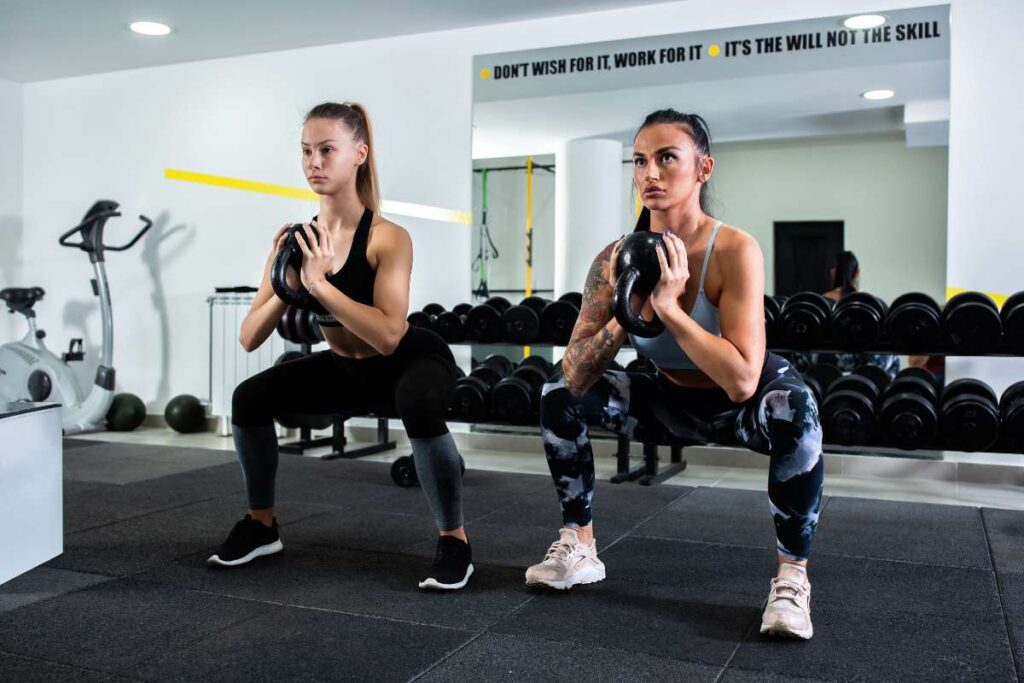
Below is a list of different squat variations to help you improve your lower strength and function.
1. Back Squats
The back is the king of all lower-body strength exercises. By using a barbell, there is an increased capacity to load up and overload the body.
Equipment Requirements
- Barbell
- Weight Plates
- Squat Rack
How To Perform a Back Squat
- Adjust the squat rack so the barbell is at collarbone height.
- Step up to the barbell and walk underneath.
- Position the barbell on the belly of your traps and across the top of your shoulder blades.
- Push up with both legs to unrack the barbell.
- Take two steps back from the rack.
- Begin the squat by unhinging at the hips and lowering to the floor.
- Lower until your hips are flexed at 90 degrees.
- Then push yourself back up to the starting position. Repeat.
Benefits
- Increase strength
- Promote muscle hypertrophy
Pro Tips
- Begin the movement by unhinging the hips. This will allow your hips to engage during the movement and let your hips, knees, and ankles move smoothly.
- Focus on breathing, inhaling as you lower and exhaling as you push yourself back up.
2. Front Squat
The front squat is an incredible exercise for developing upper and lower body strength due to the front rack position.
Equipment Requirements
- Barbell
- Squat Rack
How To Perform a Front Squat
- Adjust the squat rack so that the barbell is resting just above the height of your collarbone.
- Step under the barbell and position just above your collarbone and across the front of your shoulders.
- Cross your arms across your chest, placing your hands onto opposite shoulders, palms facing down.
- Lift your elbows up so your upper arm is parallel with the floor.
- Push up with both legs to unrack the barbell.
- Take two steps back.
- Lead back with your hips and lower yourself down toward the floor.
- Lower until your knees are bent at 90 degrees.
- Push yourself back up to the starting position. Repeat .
Benefits
- Improves physique
- Increase muscle mass
Pro Tips
- Brace the core before each inhale. This will help your torso remain rigid for the duration of the set.
- When performing the front squat, keep elbows up at all times. This will help keep the barbell secure on your collarbone.
3. Goblet Squat
The goblet squat is a great way to introduce resistance to your squats.
Typically done with a kettlebell or dumbbell, increasing load can be done in small increments, which is great for beginners.
Equipment Requirements
- Kettlebell
- Dumbbell
How To Perform Goblet Squat
- Stand holding a kettlebell with both hands at chest height.
- Start the squat by leading back with your hips and lowering yourself toward the floor.
- Lower until your hips are flexed at 90 degrees.
- Lift yourself back up to the upright position. Repeat.
Benefits
- Great for teaching squat technique and depth
- Increases strength and mass
Pro Tips
- When holding the dumbbell or kettlebell, keep elbows up for the duration of the set. This will help you hold the weight.
- Focus on your breathing, inhaling as you lower and exhaling as you push yourself back up.
4. Box Squat
The box squat is a great movement for beginners to teach you how to lower yourself to the correct depth.
It can also be highly beneficial for advanced lifters who are struggling to break through plateaus.
Equipment Requirements
- Bench/Step/Box
How To Perform the Box Squat
- Sit down on the box with only your glutes making contact.
- Position feet shoulder-width apart.
- Begin by pushing yourself up to a standing position.
- Once at the top, lead back with your hips and slowly lower yourself back down to the box.
- Allow your glutes to lightly touch the box and then push back up to standing. Repeat.
Benefits
- Great for teaching correct technique
- Useful for break through plateaus
Pro Tips
- Beginners can start with a taller box and gradually decrease the height. This will help you build strength and progress in increments.
- When performing the box squat, just lightly tap your glutes on the box. This will help with momentum, making it easier to push back up.
5. Wall Squats
Wall squats are a static movement great for building muscular endurance. Holding the static squat position, we can help improve muscle hypertrophy and tendon structure.
Equipment Requirements
- Wall
How To Perform the Wall Squat
- In the standing position, place your back against the wall with feet shoulder-width apart.
- Begin to walk your feet forward and slowly walk yourself down the wall.
- Walk the feet out until your hips and knees are bent at 90 degrees with your back flush to the wall.
- Hold this position for 10-30 seconds.
- Once complete, either walk yourself back up or lower yourself to the floor. Repeat.
Benefits
- Improve tendon strength and function
- Great for muscle hypertrophy
Pro Tips
- If you are trying this for the first time, perform for a shorter duration. This will help you get similar results and build longer holds.
- Once you finish your set, lower yourself to the floor. This will help you reduce injury.
6. Jump Squats
Jump squats are an explosive and dynamic movement that are brilliant for sport-specific training.
Equipment Requirements
- Floor Space
How To Perform Jump Squats
- Stand with feet shoulder-width apart.
- Lead back with the hips and lower yourself down toward the floor.
- Once your knees are bent at 90 degrees, explosively push and jump off the floor.
- Land with soft knees and lower into the next squat. repeat.
Benefits
- Improves explosivity
- Increases heart rate
Pro Tips
- When lowering yourself into the squat, allow your arms to come up in front of you, then swing them down to the floor as you jump.This will help propel you into the air.
- When you land, focus on landing with soft knees and go straight into the next rep. This will help you maintain momentum for the duration of the set.
7. Sumo Squat
Sumo squats are a wider-stance squat that helps to increase muscle mass and strength through the lower body.
The wide stance may also be helpful to those who are learning to squat and have the confidence in lowering themselves to parallel without losing balance.
Equipment Requirements
- Floor Space
How To Perform Sumo Squats
- Stand with feet just wider than shoulder-width apart.
- Point toes outward at a 45 degree angle.
- Begin the movement by letting hips lower toward the floor.
- Lower until your knees are bent at 90 degrees.
- Lift yourself back up to the starting position. Repeat.
Benefits
- Can help with teaching squat depth
- Improves strength and promotes hypertrophy
Pro Tips
- When performing the sumo squat, keep your knees over your toes. This improves stability and contraction of the quads and glutes.
- If you’re new to the movement and are unsure about squatting to 90 degrees hip flexion, use a box and perform a box squat until you’re comfortable with the movement.
8. Frog Squat
The frog squat is a highly effective movement for developing endurance and lengthening the hamstrings.
It is often used in tabata workouts or body weight workouts ,as it provides a different challenge compared to the conventional squat.
Equipment Requirements
- Floor Space
How To Perform Frog Squats
- Starting in the standing position, put your hands together in front of your face.
- Squat down to full depth as the entire foot maintains contact with the floor.
- Line up your elbows and your knees.
- Begin by lifting your hips up off the floor while maintaining contact between your elbows and knees.
- Lift hips until your torso is parallel with the floor.
- Lower hips back down to the starting squat position. Repeat.
Benefits
- Targets Hamstrings
- Increase Mass and Flexibility
Pro Tips
- If you are finding it difficult to get to a full squat, consider elevating the heels on a small platform. This will increase the angle at the front of the ankle and allow you to squat lower.
- This can be an uncomfortable position for beginners, so take your time and focus on the muscle contraction. It is more about the quality of the contraction than the reps you complete.
9. Pulse Squat
Pulse squats are performed in a smaller range of motion and great for burning the legs.
For this reason, they are great for circuits and outdoor training as they will get the body moving and the heart pumping. .
Equipment Requirements
- Floor Space
How To Perform the Pulse Squat
- Standing, place feet shoulder-width apart.
- Lead back with your hips and lower yourself until your hips are flexed at 90 degrees.
- Begin to pulse by pushing up to a half-squat and then lowering back down to 90 degrees.
- Repeat for the prescribed duration or rep count.
Benefits
- Builds Endurance
- Increase Muscle Mass
Pro Tips
- Focus on breathing, performing small, short breaths with each pulse.
- At the end of your set, if you’re feeling the burn, consider gently lowering to the floor. This will help you get off your feet safely without falling.
Sample of 100 Squats Per Day For 30 Day Challenge
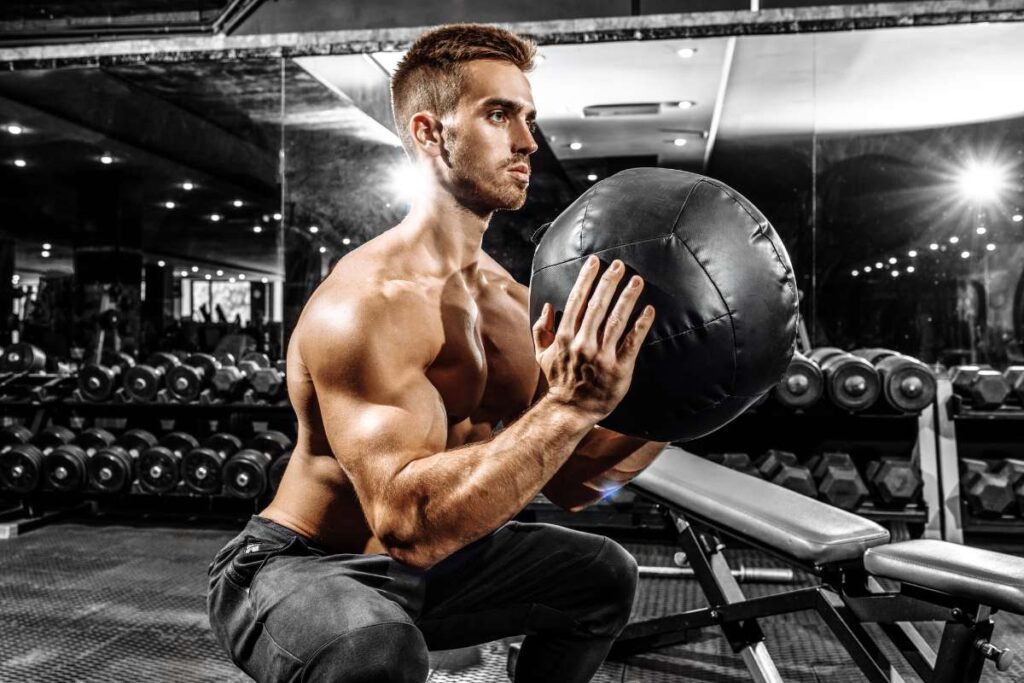
100 squats a day can sound like a daunting task because if you don’t do it right, it is. Doing them all in quick succession gets tiring fast, threatening your chances of finishing.
Below are a list of suggestions to help you ease your way into your 100 squats a day challenge.
I’ll help you to break down how to approach each day so you can build up to performing them with ease by the end of the month.
The below recommendations are for beginners using basic air squats.
However, if you’re feeling like you want to push yourself to another level, consider increasing weight or selecting any of the squat variations listed above.
The recommendations below are broken down into a number of squats per hour to make the load manageable throughout the day.
This can be modified to suit your timetable and availability. However, we recommend that you set a routine, as it will help you get into a good habit of doing them and break down the mental block that comes from this challenge.
Week 1
The first week will start with 10 squats per hour for 10 hours.
This helps you get into the habit of doing your squats without destroying you on the first day.
| Mon | Tues | Wed | Thurs | Fri | Sat | Sun |
| 10 x 10 hrs | 10 x 10 hrs | 10 x 10 hrs | 10 x 10 hrs | 10 x 10 hrs | 10 x 10 hrs | 10 x 10 hrs |
Week 2
Week two, we recommend adding some days where you do 20 squats an hour for five hours in a row.
This is to be done on alternating days to see how you adjust to an increased repetition range.
| Mon | Tues | Wed | Thurs | Fri | Sat | Sun |
| 20 x 5 hrs | 10 x 10 hrs | 20 x 5 hrs | 10 x 10 hrs | 10 x 10 hrs | 20 x 5 hrs | 10 x 10 hrs |
Week 3
Here we transition into 20 squats per hour for five hours for the entire week.
| Mon | Tues | Wed | Thurs | Fri | Sat | Sun |
| 20 x 5 hrs | 20 x 5 hrs | 20 x 5 hrs | 20 x 5 hrs | 20 x 5 hrs | 20 x 5 hrs | 20 x 5 hrs |
Week 4
In week four, we reduce the total number of hours by making you perform 25 squats over four hours, alternating the 50 squats over two hours.
| Mon | Tues | Wed | Thurs | Fri | Sat | Sun |
| 25 x 4 hrs | 50 x 2 hrs | 25 x 4 hrs | 50 x 2 hrs | 25 x 4 hrs | 50 x 2 hrs | 25 x 4 hrs |
Week 5
The final week (two days), we recommend you push yourself and go for the full 100 in an hour.
| Mon | Tues | Wed | Thurs | Fri | Sat | Sun |
| 100 x 1 hr | 100 x 1 hr | – | – | – | – | – |
Final Thoughts
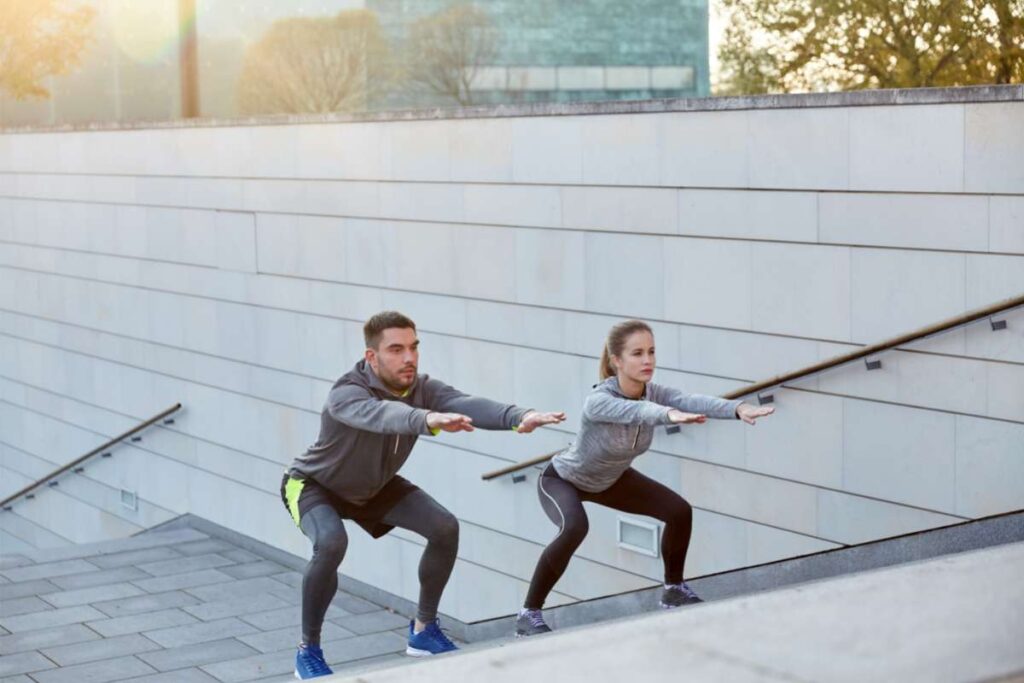
The 100 squats a day challenge has been a great way for people to put their mind and body to the test.
Since becoming a sensation back in 2018, it’s been used by many to test their resolve and endurance.
It’s also a means to return to exercise and get back in shape. It can help people regain their strength and improve their quality of life.
So, are you considering trying the 100 squats a day challenge?
Are you squatting for the first time, or are you using it to get back into your training?
Let us know in the comments.
How many calories do you burn doing squats?
Research suggests that we burn around 11 kcal per minute when we squat at 80% of our 1RM.
This is approximately 11 repetitions in total.
Do squats burn belly fat?
Squats can burn belly fat provided you are in a caloric deficit. This means that if you are burning more calories than you are consuming daily, doing squats will further that deficit, helping you lose body fat.
How long do you have to do squats to see results?
Results from squatting can be seen within the first week, as you will feel an increase in muscle activity and tone. However, regarding a significant increase in muscle mass and strength, this may take three to six months to see large hypertrophy and strength gains.
Do squats make your butt bigger?
Squats do make your butt bigger, since the exercise requires hip extension to push yourself up from the squat back up to the standing position.
What type of squats make your bum bigger?
There are many different squat variations that make your bum bigger, including, the air squat, back squat, front squat, goblet squat and sumo squat.
The main thing is that you are lowering to parallel and progressively overloading to promote muscle hypertrophy.
Do squats damage knees?
No, squats don’t damage the knees. However, like any exercise, sport, or recreational activity, if they are done incorrectly they can cause wear and tear on the joints.
If done correctly, squats can in fact improve knee health, strength, and function.
Common mistakes when doing squats?
Common mistakes when squatting include initiating the squat with the knees, lifting heels off the floor, shallow repetitions, and knocking knees. These can all be easily corrected with the assistance of fitness professionals.
Can you squat while pregnant?
Yes, you can squat while you are pregnant. Squats are a standard daily movement that we use to stand up, sit down, and lift objects. Squatting while pregnant will help you maintain strength and mobility, increase blood flow, and reduce stress.
Do squats help cellulite?
Yes, squats can help with cellulite providing you are in a calorie deficit. This will help reduce body fat and increase mass, resulting in greater muscle tone.

